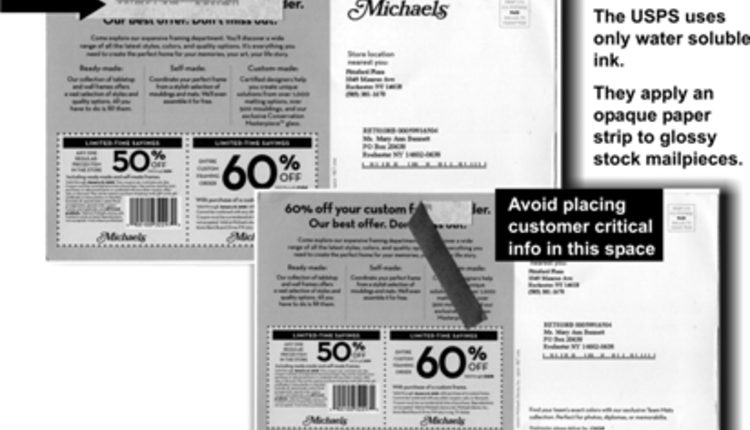My firm has been representing clients who have had some dealings with inspectors from the U.S. Postal Service Office of the Inspector General (OIG). These companies are very large First Class Permit Imprint mailers that are following postal regulations and are sending their invoices or statements, etc. as First Class mail. And being very large mailers, they also want to take every step they possibly can to claim maximized postal discounts and make sure they have the absolute most current address data on file for their customers.
For decades, they have assumed they have been Move Update compliant by anyone's standards simply because of the dollars they have spent in making sure they have call centers and processing departments in place to handle the capture of correct address information at inception and any First Class mail that is returned to them. These very large mailers have been under the impression that they have been doing a very good job at producing great mail simply because they hear it regularly from all of their local postal officials.
However, upon closer inspection by Postal Inspectors, the great mailer is informed that no USPS-approved Move Update method is being used. Even if the customer says that they will submit files for the 99% accuracy test, they would have broken a rule since they performed the test after the fact. And since this regulation has been in place since 1997, every postage discount claimed over the last 12 years could be taken away, and the inspector could even rescind mailing privileges until accessed "revenue deficiency assessments"ââ are paid. Now the highly praised mailer turns things over to legal counsel, who say, "Technically, we are non-compliant. We have to pay."
The check gets written, and the mailer's upper management immediately insists that the company moves forward to perform a GAP analysis on their compliance procedures and put steps in place to be Move Update compliant. One of the most unfortunate, but understandable, aspects of this process is that upper management also insists that they will also plan to migrate away from hard copy mail as soon as possible. So these companies have begun the process of updating their mailing lists using the methods mandated by the USPS.
Question: Are their address lists better or worse after Move Update compliance efforts? Worse, and here is why: There are multiple errors in the USPS' Move Update processes:
- Address Change Service - With this process, a mailer actually gets a scan of the original mailpiece if there is a move on file, along with a $0.50 charge for the USPS to provide the old and new address information. In some cases, the "new" address was where they sent the original mailpiece to in the first place. They were dinged $0.50 for their own, correct information!
- NCOALink - We all know that there are huge problems with the move database, which are getting bigger because of the number of non-participants. Look at the economy and house foreclosures; people are falsifying or not filling in change of address cards in an attempt to deflect credit collectors. The Postal Service is now beginning to see additional problems because they allow people to do change of address online; there are people who misuse the process by filing multiple online change of address requests.
- FASTforward - To claim maximum automation discounts, mailers often send likely non-current mailpieces over to a presort bureau, which runs them through the FASTforward system. This process will apply a more current move than what they already have in their database, if a newer address is on file. But because of anomalies in the algorithms used, FASTforward has the capability to spray on new, incorrect address information to the bottom of the mailpiece, which will get forwarded to this new, incorrect address. Here lies the bigger problem: FASTforward Move Update Notification (FFMUN). Essentially, FFMUN is the Postal Service saying, "FASTforward service providers, you now have to develop a method to facilitate providing this new move information to your client electronically."ââ As a result, the mailer could be electronically changing a correct address to an incorrect one because of the misread in the OCR.
I am all for cleaning up addresses, but I certainly don't think it is correct that people be assessed penalties for incorrect addresses when they are being forced to utilize programs that are riddled with problems.
Many in the industry, including me, are of the opinion that these mailers are being targeted because of their use of the Intelligent Mail barcode (IMb). There is a mailer ID embedded in the IMb, and many have suspected that the USPS was using that ID for purposes other than the advertised effort to increase mail delivery efficiencies. According to the "Semiannual Report on the Audit, Investigative, and Security Activities of the United States Postal Service"ââ (http://www.uspsoig.gov/sarcs/Spring09.pdf), "Revenue Protection Working directly with Postal Service personnel in various functional areas, Postal Inspectors increasingly are identifying postal revenue losses by using data-mining software and taking advantage of ongoing software enhancements of revenue-fraud detection systems. The Postal Service derives much of its revenue - nearly 50% - from Permit Imprint mail. This type of mail class represents one of the agency's most vulnerable areas of revenue risk. Working with staff from Intelligent Mail and Address Quality, Postal Inspectors are developing software enhancements to help them more quickly and easily identify revenue losses from schemes involving Permit Imprint mail."
These major mailers are not involved in a "scheme" to defraud the Postal Service in any way, shape or form. They simply have been following all of the hype from the USPS and have begun to implement IMb because they are trying to be good "postal partners."ââ Yet at this point in time, it appears the only thing the Postal Service is utilizing IMb for is to bring big mailers to the attention of Postal Inspectors.
Now, some of the biggest mailers are very quietly going to find a way to communicate with their customers without utilizing the USPS, which is unfortunate. They paid up but are going to move forward and away from mail. Postal Inspectors collect $2 million from a large Permit Imprint "postal partner"ââ for Move Update non-compliance and, in doing so, put in motion the process to ultimately lose a customer worth $20-30 million annually. Sounds like a deal only the Postal Service could make.
Mary Ann Bennett is President/CEO of The Bennett Group, Inc., a mailing training and consulting firm, and she is the founder of the Mailing Training Institute in Rochester, New York (www.mailingtraining.com). She can be reached at 585-424-2702 or maryann@the-bennett-group.com.




